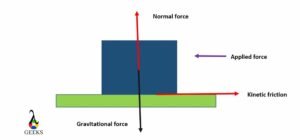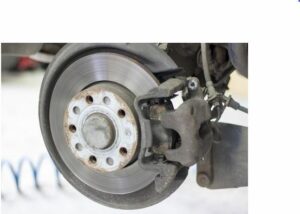Kinetic friction is a type of friction that occurs when two objects are in contact and moving relative to each other. It is the force that opposes the motion of an object sliding or moving across a surface. Unlike static friction, which acts on stationary objects, kinetic friction comes into play when there is motion involved. The magnitude of kinetic friction depends on factors such as the nature of the surfaces in contact, the force pressing the objects together, and the roughness of the surfaces. Understanding kinetic friction is crucial in various fields, including physics, engineering, and everyday life.
Key Takeaways:
| Factors Affecting Kinetic Friction |
|---|
| Nature of the surfaces in contact |
| Force pressing the objects together |
| Roughness of the surfaces |
Understanding Kinetic Friction

Kinetic friction is a fundamental concept in physics that describes the resistance encountered when two surfaces slide or move against each other. It is the force that opposes the motion of an object and is an essential aspect of everyday life. By understanding the physics behind kinetic friction, the types of movement involved, the laws governing it, and the factors that affect its strength, we can gain valuable insights into the world around us.
The Physics Behind Kinetic Friction
To comprehend kinetic friction, we need to delve into the principles of physics. When an object is in motion, it experiences a force known as friction. This force arises due to the interaction between the surfaces of the object and the surface it is moving on. Kinetic friction occurs when the object slides or moves across the surface, and it opposes the motion by exerting a force in the opposite direction.
Types of Movement in Kinetic Friction
There are two main types of movement associated with kinetic friction: sliding and rolling. Sliding friction occurs when two surfaces slide against each other, like when you drag a heavy box across the floor. Rolling friction, on the other hand, occurs when an object rolls over a surface, such as a ball rolling on the ground. Both types of movement involve the presence of kinetic friction, although the specific forces and interactions differ.
Laws of Kinetic Friction
The laws of kinetic friction govern the behavior and characteristics of this force. One of the fundamental laws is that the strength of kinetic friction depends on the normal force between the two surfaces. The normal force is the force exerted by a surface to support the weight of an object resting on it. The coefficient of kinetic friction, which varies depending on the materials in contact, also plays a crucial role in determining the strength of the frictional force.
Factors that Change the Strength of Kinetic Friction
Several factors can influence the strength of kinetic friction. One such factor is the roughness of the surfaces in contact. Rougher surfaces tend to have stronger frictional resistance compared to smoother surfaces. Additionally, the force with which an object is pressed against the surface, known as the normal force, can affect the strength of kinetic friction. The greater the normal force, the stronger the frictional force.
Other factors that can impact kinetic friction include the speed of the object’s motion, the presence of lubricants or other substances between the surfaces, and the temperature. These factors can alter the coefficient of kinetic friction and, consequently, the overall strength of the frictional force.
Understanding kinetic friction and its underlying principles is crucial in various fields, including engineering, physics, and everyday life. It helps us comprehend the resistance encountered when objects move, the energy required to overcome this resistance, and the impact it has on the efficiency of machines and systems.
Real-Life Examples of Kinetic Friction

Kinetic friction is a force that opposes the motion of an object when it slides or moves across a surface. It occurs due to the interaction between the object and the surface it is in contact with. Let’s explore some real-life examples where we can observe the effects of kinetic friction.
Rolling a Football


When you roll a football on the ground, you can feel the resistance caused by kinetic friction. The roughness of the grass or the surface creates frictional force that opposes the motion of the ball, making it harder to roll smoothly.
Swiping on a Smart Tab



Using a smart tab or a touchscreen device involves kinetic friction. As you swipe your finger across the screen, the friction between your finger and the screen allows you to control the movement and interact with the device.
Using an Ink-rubber to Erase


When you use an ink-rubber to erase pencil marks on paper, you can feel the friction between the rubber and the paper. The friction helps to remove the graphite from the surface, allowing you to erase the marks effectively.
Roller Skating



Roller skating is a fun activity that involves sliding on wheels. The kinetic friction between the wheels and the ground provides the necessary grip to propel yourself forward and control your movement.
Swimming

Even in water, kinetic friction plays a role. As you swim, the friction between your body and the water helps you move through it. The resistance provided by the water allows you to generate propulsion and swim efficiently.
Combing Hair

When you comb your hair, you may notice some resistance as the comb moves through your hair. This is due to the kinetic friction between the comb‘s teeth and your hair strands. The friction helps to detangle and style your hair.
Cleaning with a Vacuum Cleaner



Using a vacuum cleaner involves the interaction of kinetic friction. As the brush or nozzle moves across the floor, the friction between the cleaning head and the surface helps to remove dirt and debris, ensuring effective cleaning.
Swiping a Card


When you swipe a card, such as a credit card or an access card, through a card reader, you can feel the resistance caused by kinetic friction. The friction between the card and the reader’s slot allows the necessary contact for the information to be read.
These examples demonstrate how kinetic friction is present in our everyday lives. Whether it’s rolling a football, swiping on a smart tab, or using a vacuum cleaner, the force of friction opposes the motion and affects our interactions with objects and surfaces. Understanding the physics principles behind kinetic friction can help us navigate and make sense of the world around us.
Applying Brakes on Wheels

Blood Flow in the Body
When it comes to applying brakes on wheels, understanding the concept of friction is crucial. Friction is the force that opposes the motion between two surfaces in contact. In the case of wheels, it is the force that slows down or stops the rotation of the wheels when brakes are applied. Let’s delve deeper into the physics behind this process.
Friction can be categorized into two types: static friction and kinetic friction. Static friction occurs when there is no relative motion between the surfaces in contact. On the other hand, kinetic friction comes into play when there is relative motion between the surfaces. In the context of applying brakes on wheels, we are primarily concerned with kinetic friction.
The frictional force between the brake pads and the wheel is what allows the brakes to slow down or stop the rotation of the wheels. This force is generated due to the interaction between the two surfaces and is influenced by various factors such as the coefficient of kinetic friction, surface roughness, and the normal force acting on the wheel.
To calculate the frictional force, we can use the kinetic friction formula:
Frictional Force = Coefficient of Kinetic Friction * Normal Force
The coefficient of kinetic friction is a property of the materials in contact and represents the amount of friction between them. The normal force is the force exerted by the surface on the wheel perpendicular to the contact surface.
The laws of friction govern the behavior of frictional forces. These laws state that the frictional force is directly proportional to the normal force and depends on the nature of the surfaces in contact. Additionally, the frictional force is independent of the area of contact between the surfaces.
In the context of applying brakes on wheels, the frictional force opposes the motion of the wheel, providing the necessary resistance to slow down or stop the wheel’s rotation. This resistance is essential for controlling the speed and ensuring the safety of the vehicle.
In everyday life, we encounter numerous examples of kinetic friction. When we walk, the friction between our shoes and the ground allows us to move forward without slipping. When we slide a book on a table, the friction between the book and the table’s surface slows down its motion. Even when we ride a bicycle, the friction between the brake pads and the wheel helps us control our speed.
Understanding the physics principles behind friction and its role in applying brakes on wheels is crucial for engineers and designers in the automotive industry. By studying frictional resistance, surface roughness, and motion resistance, they can optimize braking systems to ensure efficient and safe braking.
Stamping

Stamping is a process used in various industries to create patterns, designs, or markings on different materials. It involves the application of pressure or force on a surface using a stamp or die, resulting in the transfer of the desired image onto the material. This technique is commonly used in printing, manufacturing, and even arts and crafts.
Stamping can be done on a wide range of materials, including paper, metal, plastic, and fabric. It offers a cost-effective and efficient way to add decorative or functional elements to products. Whether it’s adding a logo to a product, creating intricate patterns on paper, or embossing designs on metal, stamping provides a versatile solution.
The Physics of Kinetic Friction
When it comes to stamping, understanding the concept of kinetic friction is essential. Kinetic friction is the force that opposes the motion of an object when it slides or moves across a surface. It occurs due to the interactions between the surfaces of the object and the surface it is sliding on.
The frictional force between two surfaces depends on several factors, including the type of surfaces involved, the normal force pressing the surfaces together, and the coefficient of kinetic friction. The coefficient of kinetic friction is a value that represents the roughness or smoothness of the surfaces in contact.
To better understand the physics behind kinetic friction, let’s consider an example. Imagine a wooden block sliding on a table. As the block moves, the roughness of the table’s surface creates resistance, opposing the motion of the block. This resistance is the frictional force at play.
The laws of friction govern the behavior of kinetic friction. These laws state that the frictional force is directly proportional to the normal force and the coefficient of kinetic friction. In other words, the greater the normal force or the coefficient of kinetic friction, the stronger the frictional force opposing the motion.
In everyday life, we encounter numerous examples of kinetic friction. When we walk, the friction between our shoes and the ground allows us to move forward without slipping. The brakes in a car utilize kinetic friction to slow down or stop the vehicle. Even the simple act of writing with a pen involves the friction between the pen tip and the paper.
The Coefficient of Kinetic Friction
The coefficient of kinetic friction plays a crucial role in determining the strength of the frictional force. It is a dimensionless value that varies depending on the materials in contact. The coefficient represents the ratio of the frictional force to the normal force between the surfaces.
Different materials have different coefficients of kinetic friction. For example, the coefficient of kinetic friction between rubber and concrete is higher than that between ice and metal. This difference in coefficients affects the amount of force required to overcome the friction and initiate motion.
To calculate the frictional force, we can use the kinetic friction formula:
Frictional Force = Coefficient of Kinetic Friction × Normal Force
By knowing the coefficient of kinetic friction and the normal force, we can determine the magnitude of the frictional force opposing the motion.
Real-Life Examples of Kinetic Friction
Kinetic friction is present in various aspects of our daily lives. Here are some real-life examples:
-
Sliding a book across a table: When you push a book across a table, the friction between the book and the table’s surface opposes the motion, making it harder to slide smoothly.
-
Braking a bicycle: When you apply the brakes on a bicycle, the friction between the brake pads and the wheel rims creates a force that slows down the bike.
-
Opening a door: The friction between the doorknob and your hand allows you to exert a force and open the door.
-
Using sandpaper: Sandpaper is used to smoothen or shape surfaces by creating friction that removes material.
These examples demonstrate how kinetic friction affects our interactions with objects and surfaces in our daily lives.
Kinetic Friction in Engineering

Role of Kinetic Friction in Engineering Designs
In engineering, kinetic friction plays a crucial role in the design and functionality of various systems and structures. It refers to the resistance encountered when two surfaces are in relative motion. Unlike static friction, which opposes the initiation of motion, kinetic friction opposes the movement of objects that are already in motion.
The physics of kinetic friction is governed by several factors, including the nature of the surfaces in contact, the normal force between them, and the coefficient of kinetic friction. The coefficient of kinetic friction is a dimensionless value that quantifies the frictional resistance between two surfaces. It is influenced by surface roughness, motion resistance, and other factors.
To better understand the concept, let’s take a look at some practical examples of how kinetic friction is applied in engineering:
Example 1: Sliding Mechanisms
In many engineering designs, sliding mechanisms are employed to facilitate smooth movement between two components. Kinetic friction plays a vital role in ensuring controlled and precise motion. By providing the necessary opposing force, it prevents the objects from sliding too easily or with excessive resistance.
Example 2: Braking Systems
Braking systems in vehicles rely on kinetic friction to slow down or stop the motion of the wheels. When the brake pads press against the rotating wheel, the frictional force generated converts the kinetic energy of the moving vehicle into heat energy, resulting in deceleration. The coefficient of kinetic friction between the brake pads and the wheel surface is carefully considered to ensure optimal braking performance.
Example 3: Conveyor Belts

Conveyor belts are extensively used in industries to transport materials from one location to another. Kinetic friction between the belt and the objects being conveyed helps to prevent slipping and ensures efficient movement. The coefficient of kinetic friction is taken into account when designing conveyor systems to ensure the objects are securely transported without unnecessary slippage.
Practical Examples in Engineering
Here are a few more real-life examples where the understanding and application of kinetic friction are essential in engineering:
- Bearings and bushings: Kinetic friction is carefully managed in the design of bearings and bushings to minimize frictional resistance and ensure smooth rotation or sliding motion.
- Gears and transmissions: Kinetic friction is utilized in gears and transmissions to transfer motion and power efficiently while minimizing energy losses due to friction.
- Suspension systems: Kinetic friction is considered in the design of suspension systems to provide controlled damping and ensure stability and comfort during vehicle movement.
- Robotics and automation: Kinetic friction is taken into account in the design of robotic systems to ensure precise and accurate movement of robotic arms and components.
By understanding the principles of kinetic friction, engineers can optimize the performance and reliability of various systems and structures. Whether it’s controlling motion, providing stability, or minimizing energy losses, the role of kinetic friction in engineering designs is undeniable.
FAQs on Kinetic Friction
Is Kinetic Friction a Self-adjusting Force?
Kinetic friction is not a self-adjusting force. It remains constant as long as the object is in motion and sliding against a surface. The force of kinetic friction opposes the motion of the object, and its magnitude depends on the coefficient of kinetic friction and the normal force between the object and the surface. The coefficient of kinetic friction is a property of the materials in contact and determines the amount of frictional force generated.
What Effect Does Friction Have on a Moving Object?
Friction plays a crucial role in the motion of objects. When an object is in motion, kinetic friction acts in the opposite direction to the object’s motion. It opposes the movement and causes the object to slow down. The amount of frictional force depends on the coefficient of kinetic friction and the normal force. Higher coefficients of kinetic friction and greater normal forces result in larger frictional forces, which can significantly affect the speed and acceleration of the object.
Friction also affects the stability of an object in motion. It provides the necessary grip between the object and the surface, preventing slipping or sliding. This is particularly important in scenarios such as driving a car, where the friction between the tires and the road allows for control and maneuverability.
Does Kinetic Energy Equal Work Done?
No, kinetic energy and work done are not the same. Kinetic energy is the energy possessed by an object due to its motion. It depends on the mass of the object and its velocity. The formula for kinetic energy is KE = 1/2 * m * v^2, where m is the mass of the object and v is its velocity.
On the other hand, work done is the transfer of energy that occurs when a force acts on an object and causes it to move. The work done is calculated by multiplying the force applied to the object by the distance over which the force is applied. The formula for work done is W = F * d * cos(theta), where F is the force applied, d is the displacement, and theta is the angle between the force and the displacement vectors.
While kinetic energy and work done are related, they are not equal. Kinetic energy represents the energy of motion, while work done represents the transfer of energy from one object to another.
How does understanding kinetic friction in everyday life relate to examples of kinetic friction?
Understanding the concept of kinetic friction in everyday life is crucial in order to comprehend and apply examples of kinetic friction effectively. Kinetic friction plays a vital role in our daily activities and interactions with objects. By understanding the principles of kinetic friction, we can gain insights into how various examples of this force occur in real-life scenarios. To explore the intersection between these themes in more detail, you can check out examples of kinetic friction in different contexts by visiting Kinetic friction in everyday life.
Frequently Asked Questions
1. What is the Definition of Kinetic Friction?
Kinetic friction, also known as dynamic friction, is the force that opposes the relative motion of two surfaces in contact when one object is moving. It is determined by the equation F = μkN, where F is the force of friction, μk is the coefficient of kinetic friction, and N is the normal force.
2. Can you provide an Example of Kinetic Friction?
An example of kinetic friction is when you slide a book across a table. The friction between the book and the table surface slows down and eventually stops the book’s movement. This is kinetic friction in action.
3. What is the Difference between Kinetic Friction and Static Friction?
Static friction is the force that keeps an object at rest. It must be overcome to start moving the object. On the other hand, kinetic friction is the force that resists the motion of an object. It is always less than or equal to the maximum static friction.
4. How does the Law of Kinetic Friction work?
The law of kinetic friction states that the force of kinetic friction between two surfaces is proportional to the normal force and does not depend on the area of contact. It is given by the equation F = μkN, where F is the force of friction, μk is the coefficient of kinetic friction, and N is the normal force.
5. What is the Role of Friction in Movement?
Friction plays a crucial role in movement. Without friction, we would not be able to walk, drive, or even hold objects. Friction provides the necessary grip or traction that allows objects to move without slipping.
6. How does Kinetic Friction change the Strength of Movement?
Kinetic friction can either slow down or stop the movement of an object. The strength of the movement depends on the magnitude of the kinetic friction. The greater the friction, the more quickly the object will come to a stop.
7. Can you explain the Applications of Kinetic Friction with the help of an Animation?
Kinetic friction is applied in various fields like engineering, animation, and physics. For instance, in animation, kinetic friction is used to create realistic movements. When a character slides or moves, the animator must consider the friction between the character and the surface to make the movement appear natural.
8. What are some Examples of Kinetic Friction in our Daily Life?
In our daily life, we experience kinetic friction frequently. For example, when we write with a pencil, the friction between the pencil lead and the paper allows the graphite to leave a mark. When we walk or run, the friction between our shoes and the ground prevents us from slipping.
9. How does Friction affect a Moving Object?
Friction acts to resist the motion of a moving object. Depending on its magnitude, friction can slow down, stop, or change the direction of the object’s movement. It converts kinetic energy into heat, causing a decrease in the object’s speed.
10. What is the Kinetic Friction Equation and its Importance?
The kinetic friction equation is F = μkN, where F is the force of friction, μk is the coefficient of kinetic friction, and N is the normal force. This equation is important as it allows us to calculate the force required to keep an object moving at a constant velocity, or to predict how quickly an object will decelerate under the influence of friction.
Also Read:
- Find coefficient of friction given velocity and distance
- Difference between friction and viscosity
- Kinetic friction vs kinetic force
- How to find normal force with coefficient of friction
- Friction welding
- Where is friction not useful
- How to find acceleration with coefficient of friction
- Bad friction
- Why static friction is greater than kinetic
- Relative motion in friction

I am Raghavi Acharya, I have completed my post-graduation in physics with a specialization in the field of condensed matter physics. I have always considered Physics to be a captivating area of study and I enjoy exploring the various fields of this subject. In my free time, I engage myself in digital art. My articles are aimed towards delivering the concepts of physics in a very simplified manner to the readers.